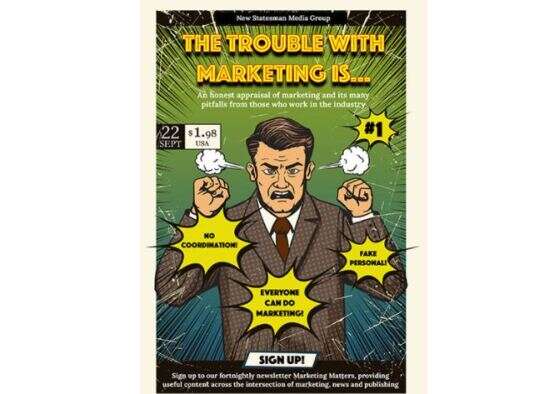
Craig Hawtin-Butcher is Managing Director of BHA Media in Sydney, Australia, and a former journalist and editorial director in the UK, and features in the latest of Press Gazette’s Marketing Maestro interviews. This series is produced in association with Lead Monitor, New Statesman Media Group’s AI-driven marketing solution.
What’s been your proudest achievement in your current role?
The Intermedia Group is one of Australia and New Zealand’s biggest B2B publishers. But when COVID hit in 2020 and advertiser revenue streams became more challenged, we swiftly pivoted to focus on content delivery and our channel mix to double our online audiences. Social followers went through the roof, page views and dwell time likewise. The appetite for news and analysis was at times insatiable. When the New Zealand government shut down the printers, it made it impossible to deliver to our audiences in print there. So we increased our e-mail newsletter frequencies, produced digimags and focused on breaking news and expert analysis online to satisfy huge demand for industry insights. We grew audiences both here in Australia and New Zealand, in their time of need – building greater loyalty and trust through quality journalism. Advertisers and partners have returned in greater numbers than before, many having discovered the value of digital experiences for the first time. That, for me, has been very satisfying.
What media channels do you see as most important and best value when it comes to marketing spend and activity?
Without dodging the question, all of them. Right now, there are many businesses focused on shorter-term strategies because the business environment can seem so uncertain. For them, our ability to deliver trackable ROI online and via social, and execute campaigns at short-notice, is hugely valuable.
For other brands planning for the uptick post-lockdowns and with consistent medium-to-long term marketing plans – many of whom have partnered with us for decades – print is an important part of the mix.
And despite the difficulties around face-to-face networking and events, which are a key facet of our overall touchpoints with audiences, we’ve continued to see massive growth in interest from both attendees and brands.
Download New Statesman Media Group’s latest white paper: The trouble with marketing is…
An honest appraisal of marketing and its many pitfalls from those who work in the industry.
What is the key difference in B2B and B2C marketing?
For us, it’s all about supremely high-quality, targeted audiences – business owners, decision-makers. When we talk about influencers in this space, we’re talking about the industry titans whose approaches and business choices move their industry. When we talk about reach, we mean precisely and only those members and suppliers of the industry our verticals exist for. We connect with as close to 100% of our target audiences as we possibly can, across channels, but we’re not preoccupied by attracting broad though irrelevant reach via SEO, for example. That can mean B2B audience numbers can seem smaller than other mass-media B2C platforms, but it means we’re already segmenting our audiences to connect the right customers with advertisers and partners. We’re effectively removing irrelevancy much earlier in the funnel.
What for you is the key to any successful marketing campaign – what actually makes a ‘good lead’?
Genuinely motivated leads. Yes it’s possible to attract data capture through competitions on social, for example, but often we find those leads are less valuable to our brand partners. On the other hand, an 8- or 16-page expert supplementary report on the state of the beauty industry in partnership with a leading brand, attracts exactly the sort of quality lead that is actionable for our partners. In essence, we’re in the business not of giveaways to attract audiences but value-adds, where we’re creating value in the exchange between audiences and brands. Audiences recognise brands that are adding value to their business knowledge, and will reward them. Those ambassadorial leads can be incredibly powerful leads.
How important is technology in modern marketing?
Certainly it’s incredibly important from a reporting and ROI side – proving out value of different approaches and platforms to marketers drives future bookings and spend. It’s vital that marketers derive results from their bookings, and technology makes proper analysis of that possible.
But beyond that, there are some powerful systems we’ve invested in to master our CRM capabilities, so we can much better segment our audiences, cross-pollinate them, as well as to simplify the ad booking process for clients, source creative assets, etc.
Editorially, too, technology is making a whole range of interactive story-telling possible – we now embed videos in our magazine’s ‘Editor’s Letter’ sections, weekly live sessions on Facebook and Instagram, for example. It’s giving our creative and editorial teams a huge number of opportunities to engage with our readers.
What are the biggest pain points in a marketing campaign?
Typically it’s around creative assets and third-party requirements. We work with a number of brands of all sizes and sometimes a product is too new to have been shot creatively, or isn’t sufficiently localised for use, for example. Or they simply don’t have creative. Over time we have vastly expanded our in-house creative and production capabilities so that we’re able to deliver end-to-end solutions for our advertisers – creative, production and distribution.
And finally, if you could ask your peers for one piece of advice or help, what would it be?
What are you seeing on the ground in your business? I’m constantly interested in discovering how different sectors of the economy are doing, what new editorial approaches journalists are trying out and what different brands’ experiences are.
Email pged@pressgazette.co.uk to point out mistakes, provide story tips or send in a letter for publication on our "Letters Page" blog

